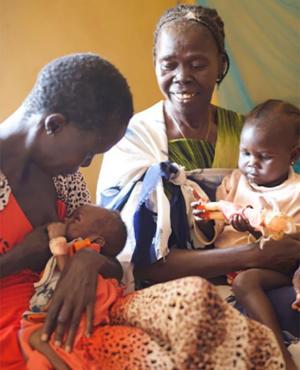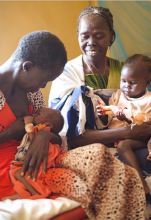In South Sudan, grandmothers breastfeed malnourished grandchildren
It’s a busy morning at the inpatient unit for malnourished children at the Wau Teaching Hospital in Western Bahr el Ghazal, north-east South Sudan. The sound of babies’ fitful crying fills the air.
Sitting on a hospital bed, a middle-aged woman offers her milk-empty breast to her grandbaby. The baby, Akot, is suffering from severe acute malnutrition and tuberculosis. Her mother recently died of tuberculosis. Medical staff hope that the baby’s suckling will stimulate milk production within Ajonga, her grandmother, and that this, combined with therapeutic feeding, will return Akot to normal health.
Both grandmother and baby seem distressed.
Another middle-aged woman slips onto the bed next to Ajonga. Tereza was in the same position not so long ago – a grandmother struggling to feed her orphaned granddaughter. Now the little girl, Bakhita, is a vision of healthiness.
“Don’t give up,” Tereza tells Ajonga. “Look how healthy my baby is. You have to be determined. Please keep trying.”
In a country with alarmingly high rates of acute malnutrition, which have progressively worsened since the start of civil war in 2013, the recovery of Bakhita to glowing health is a welcome success story. It is also testament to the commitment of the nutrition staff at Wau Teaching Hospital and the work of the South Sudan Ministry of Health, with support from the World Health Organization (WHO), to improve the situation.
Bakhita’s parents were killed during an attack on their village just outside of Wau. Bakhita and Tereza survived, fleeing to the United Nations Protection of Civilians centre (a temporary shelter for displaced persons) in Wau. At that time, Bakhita was 3 months old. During the first month at the civilian centre, Tereza was given formula for Bakhita, but the little girl was already malnourished. When she contracted chicken pox, her condition deteriorated rapidly.
“The people [at the civilian centre] saw that the child’s condition was critical,” remembers Tereza. “So they referred us here.” Bakhita spent three and a half months receiving inpatient care in the Wau Teaching Hospital.
Elevated child malnutrition rates
South Sudan’s elevated malnutrition rates are driven by unprecedented levels of food insecurity, high prevalence of communicable diseases, poor infant and young child feeding practices, limited access to health services, protracted conflict with mass displacement and economic crises, according to Marina Adrianopoli, Technical Officer for Nutrition at WHO South Sudan.
“Estimates for 2019 suggest that nearly 260 000 children will suffer from severe acute malnutrition, affecting more than 11% of children younger than 5 in South Sudan,” she says.
The WHO Emergency Nutrition Programme in South Sudan emphasizes improving the inpatient management of severe acute malnutrition with medical complications – exactly the kind of care Bakhita benefited from.
Between 2016 and 2018, WHO helped the Ministry of Health update the National Guidelines of Inpatient Management of Severe Acute Malnutrition with Medical Complications. These provide practical and easy-to-follow guidance on life-saving practices based on the most recent evidence about the inpatient management of severe acute malnutrition.
WHO has also designed programmes to build up the skills of medical doctors and clinical officers in the management of severe acute malnutrition. To date, more than 1 500 health and nutrition workers have been trained as trainers to provide improved quality and life-saving patient care.
One of the beneficiaries of this training is Dr Santino Gai, who arrived in Wau in 2017 after finishing his medical studies in Khartoum, Sudan. He now passes on his knowledge to the nurses, students and junior medics with whom he works.
“They are now able to identify malnourished children and do assessments to detect the presence of acute malnutrition,” he says.
In 2016, WHO also launched a kit containing basic and essential medicines for the treatment of severe acute malnutrition and medical complications in children, with South Sudan becoming the first country globally to use it. In 2018, more than 3 700 children were treated using these kits, which are provided to inpatient treatment centres as a stop-gap measure to ensure the sustainability of care and to prevent deaths.
“The impact of the WHO work in nutrition is measurable in the reduced mortality rates in stabilization centres, which was below 5% in 2018” says Adrianopoli. “But impacts are also apparent in the stories we hear about patients, including Bakhita. Although it’s sad she lost her parents, it’s wonderful that she is now such a healthy baby and really thriving. And it’s great that the grandmother is now encouraging other women at the inpatient centre.”
Once malnourished, babies are thriving
Before she left the hospital with Bakhita, Tereza was updated on good feeding and proper hygiene practices for children. She now makes sure Bakhita washes her hands before eating and has meals with a variety of foods throughout the day.
“I make breakfast for the child in the morning, and after that I prepare porridge and sauce for her. In the evening, I prepare food for the baby again,” says Tereza. “I try to feed her three times a day. And I have also fed Bakhita on my milk up to now.”
Meanwhile, three weeks after entering into the malnutrition unit, baby Akot and her grandmother are both doing well. The baby is recovering, gaining weight and expected to soon be discharged.




